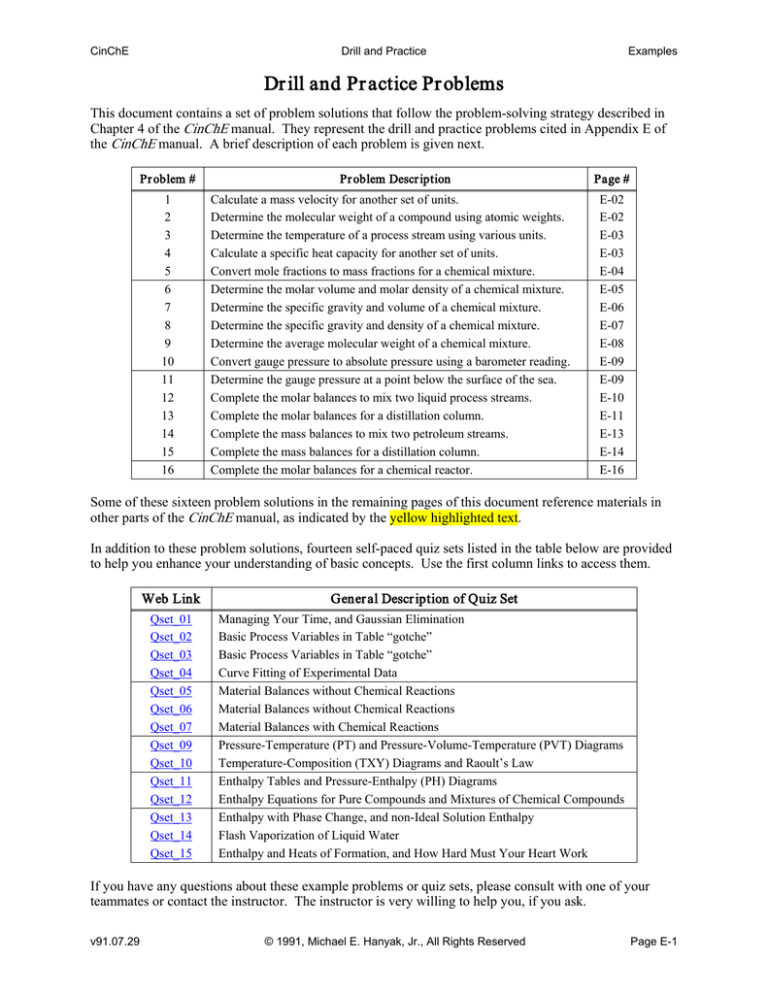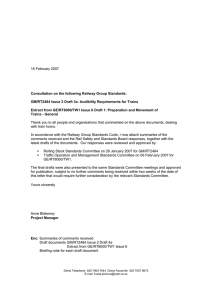
CinChE
Drill and Practice
Examples
Dr ill and Pr actice Pr oblems
This document contains a set of problem solutions that follow the problem-solving strategy described in
Chapter 4 of the CinChE manual. They represent the drill and practice problems cited in Appendix E of
the CinChE manual. A brief description of each problem is given next.
Pr oblem #
1
2
3
4
5
6
7
8
9
10
11
12
13
14
15
16
Pr oblem Descr iption
Calculate a mass velocity for another set of units.
Determine the molecular weight of a compound using atomic weights.
Determine the temperature of a process stream using various units.
Calculate a specific heat capacity for another set of units.
Convert mole fractions to mass fractions for a chemical mixture.
Determine the molar volume and molar density of a chemical mixture.
Determine the specific gravity and volume of a chemical mixture.
Determine the specific gravity and density of a chemical mixture.
Determine the average molecular weight of a chemical mixture.
Convert gauge pressure to absolute pressure using a barometer reading.
Determine the gauge pressure at a point below the surface of the sea.
Complete the molar balances to mix two liquid process streams.
Complete the molar balances for a distillation column.
Complete the mass balances to mix two petroleum streams.
Complete the mass balances for a distillation column.
Complete the molar balances for a chemical reactor.
Page #
E-02
E-02
E-03
E-03
E-04
E-05
E-06
E-07
E-08
E-09
E-09
E-10
E-11
E-13
E-14
E-16
Some of these sixteen problem solutions in the remaining pages of this document reference materials in
other parts of the CinChE manual, as indicated by the yellow highlighted text.
In addition to these problem solutions, fourteen self-paced quiz sets listed in the table below are provided
to help you enhance your understanding of basic concepts. Use the first column links to access them.
Web Link
Gener al Descr iption of Quiz Set
Qset_01
Qset_02
Qset_03
Qset_04
Qset_05
Qset_06
Qset_07
Qset_09
Qset_10
Qset_11
Qset_12
Qset_13
Qset_14
Qset_15
Managing Your Time, and Gaussian Elimination
Basic Process Variables in Table “gotche”
Basic Process Variables in Table “gotche”
Curve Fitting of Experimental Data
Material Balances without Chemical Reactions
Material Balances without Chemical Reactions
Material Balances with Chemical Reactions
Pressure-Temperature (PT) and Pressure-Volume-Temperature (PVT) Diagrams
Temperature-Composition (TXY) Diagrams and Raoult’s Law
Enthalpy Tables and Pressure-Enthalpy (PH) Diagrams
Enthalpy Equations for Pure Compounds and Mixtures of Chemical Compounds
Enthalpy with Phase Change, and non-Ideal Solution Enthalpy
Flash Vaporization of Liquid Water
Enthalpy and Heats of Formation, and How Hard Must Your Heart Work
If you have any questions about these example problems or quiz sets, please consult with one of your
teammates or contact the instructor. The instructor is very willing to help you, if you ask.
v91.07.29
© 1991, Michael E. Hanyak, Jr., All Rights Reserved
Page E-1
CinChE
CinChE
Drill Problem
and Practice
Example
Solutions
ExamplesE
Appendix
see units equivalences in Table "gotche", Page 3-3
see Page A-18
v91.07.29
v91.07.29
© 2007, Michael E. Hanyak, Jr., All Rights Reserved
© 1991, Michael E. Hanyak, Jr., All Rights Reserved
Page E-2
Page E-2
CinChE
CinChE
Drill Problem
and Practice
Example
Solutions
ExamplesE
Appendix
see Page 3-9
see units equivalences in Table "gotche", Page 3-3 and 3-6
v91.07.29
v91.07.29
© 2007, Michael E. Hanyak, Jr., All Rights Reserved
© 1991, Michael E. Hanyak, Jr., All Rights Reserved
Page E-3
Page E-3
CinChE
CinChE
Drill Problem
and Practice
Example
Solutions
ExamplesE
Appendix
or
see Appendix D:
v91.07.29
v91.07.29
© 2007, Michael E. Hanyak, Jr., All Rights Reserved
© 1991, Michael E. Hanyak, Jr., All Rights Reserved
Page E-4
Page E-4
CinChE
CinChE
Drill Problem
and Practice
Example
Solutions
ExamplesE
Appendix
^
V
^
ɉ
^
V
see Page 3-12
^
^
V
V
^
ɉ
^
V
^
ɉ
^
V
^
ɉ
^
V
^
V
^
ɉ
v91.07.29
v91.07.29
© 2007, Michael E. Hanyak, Jr., All Rights Reserved
© 1991, Michael E. Hanyak, Jr., All Rights Reserved
Page E-5
Page E-5
CinChE
CinChE
Drill Problem
and Practice
Example
Solutions
ExamplesE
Appendix
7
L
see Appendix D:
Click here for definition of API gravity.
L
v91.07.29
v91.07.29
© 2007, Michael E. Hanyak, Jr., All Rights Reserved
© 1991, Michael E. Hanyak, Jr., All Rights Reserved
Page E-6
Page E-6
CinChE
CinChE
Drill Problem
and Practice
Example
Solutions
ideal solution
ExamplesE
Appendix
Click here for definition of API gravity.
see Appendix D:
v91.07.29
v91.07.29
© 2007, Michael E. Hanyak, Jr., All Rights Reserved
© 1991, Michael E. Hanyak, Jr., All Rights Reserved
Page E-7
Page E-7
CinChE
CinChE
Drill Problem
and Practice
Example
Solutions
ExamplesE
Appendix
see Appendix D:
v91.07.29
v91.07.29
© 2007, Michael E. Hanyak, Jr., All Rights Reserved
© 1991, Michael E. Hanyak, Jr., All Rights Reserved
Page E-8
Page E-8
CinChE
CinChE
Drill Problem
and Practice
Example
Solutions
ExamplesE
Appendix
see Table "gotche"
in Ch. 3, Page 3-4
psig.
see Page 3-10
v91.07.29
v91.07.29
© 2007, Michael E. Hanyak, Jr., All Rights Reserved
© 1991, Michael E. Hanyak, Jr., All Rights Reserved
Page E-9
Page E-9
CinChE
Drill and Practice
Examples
A light oil containing 75 mol% C9 and 25 mol% C11 is mixed with a heavy oil containing 20 mol
% C9 and 80 mol% C11. What molar flow rate of the light oil must be mixed with the heavy oil to
produce a desired liquid fuel containing 35 mol% C9 and 65 mol% C11 that flows at 100 lb-mol
per second?
temperatures and pressures were not listed in the
diagram, since they are not needed in the solution
see Page 5-6
see Gaussian Elimination on Page C-8
v91.07.29
© 1991, Michael E. Hanyak, Jr., All Rights Reserved
Page E-10
CinChE
Drill and Practice
Examples
A stream of natural gasoline is feed to a distillation column to produce a medium-octane gasoline as a
bottoms stream and an overhead distillate stream of lighter hydrocarbons. Based on the data in the table
below, how many liters per day of medium-octane gasoline can be produced from 50,000 bbl/d of natural
gasoline?
Feed
Bottoms
Product
Mol. Wt.
--------------------------------------------C6H14
25 mol%
0 mol%
60 mol%
86
25 mol%
22 mol%
30 mol%
100
C7H16
50 mol%
78 mol%
10 mol%
114
C8H18
The mass density for each of the three streams is 0.8 g/cm3.
temperatures and pressures were not listed in the
diagram, since they are not needed in the solution
see Page 5-6 and Table "gotche"
v91.07.29
© 1991, Michael E. Hanyak, Jr., All Rights Reserved
Page E-11
CinChE
Drill and Practice
Examples
L/d
L/d
Click here to find the units equivalence between U.S. petroleum barrel (bbl) and cm3.
v91.07.29
© 1991, Michael E. Hanyak, Jr., All Rights Reserved
Page E-12
CinChE
Drill and Practice
Examples
Heavy naphtha from one process unit (Stream A) is mixed with heavy naphtha from another process unit
(Stream B) to produce the feed (Stream F) that enters a third process unit. Stream A contains 60 percent C6
and 40 percent C8 hydrocarbons. Stream B contains 50 percent C6 and 50 percent C8 hydrocarbons.
Stream F contains 53 percent C6 and 47 percent C8 hydrocarbons. For a Stream A flow rate of 200 kg/s,
what is the ratio of heavy naphtha in Stream A to that in Stream B?
temperatures and pressures were not listed in the
diagram, since they are not needed in the solution
see Page 5-2
v91.07.29
© 1991, Michael E. Hanyak, Jr., All Rights Reserved
Page E-13
CinChE
Drill and Practice
Examples
Part A. A feed to a stripping column flows at 18,000 bbl per hour and contains 58.3 percent by mass
kerosene and 41.7 percent light hydrocarbons. The vapor stream leaving the top of the stripping column
contains only the light hydrocarbons, while the liquid stream leaving the bottom of the stripping column
contains only the kerosene. For this perfect separation, what is the flow rate in lbm/h of the of the kerosene
leaving the stripping column? The specific gravity of the feed is 32° API.
Part B. A perfect separation is not what happens in practice. Typically, pure kerosene is produced as a
liquid in the bottoms stream of the stripper, and the vapor stream contains 80 percent by mass light
hydrocarbons and 20 percent kerosene. Under these conditions, how much kerosene is produced?
see Page 5-2 and Table "gotche"
Click here for definition of API gravity.
mK in lbm / h
v91.07.29
© 1991, Michael E. Hanyak, Jr., All Rights Reserved
Page E-14
CinChE
Drill and Practice
Examples
see Page 5-2
v91.07.29
© 1991, Michael E. Hanyak, Jr., All Rights Reserved
Page E-15
CinChE
CinChE
Drill Problem
and Practice
Example
Solutions
ExamplesE
Appendix
16
temperatures and pressures were not listed in the
diagram, since they are not needed in the solution
see Page 5-6
v91.07.29
v91.07.29
© 2007, Michael E. Hanyak, Jr., All Rights Reserved
© 1991, Michael E. Hanyak, Jr., All Rights Reserved
Page E-16
Page E-16
CinChE
CinChE
Drill Problem
and Practice
Example
Solutions
ExamplesE
Appendix
g-rxn / hr
v91.07.29
v91.07.29
© 2007, Michael E. Hanyak, Jr., All Rights Reserved
© 1991, Michael E. Hanyak, Jr., All Rights Reserved
Page E-17
Page E-17

